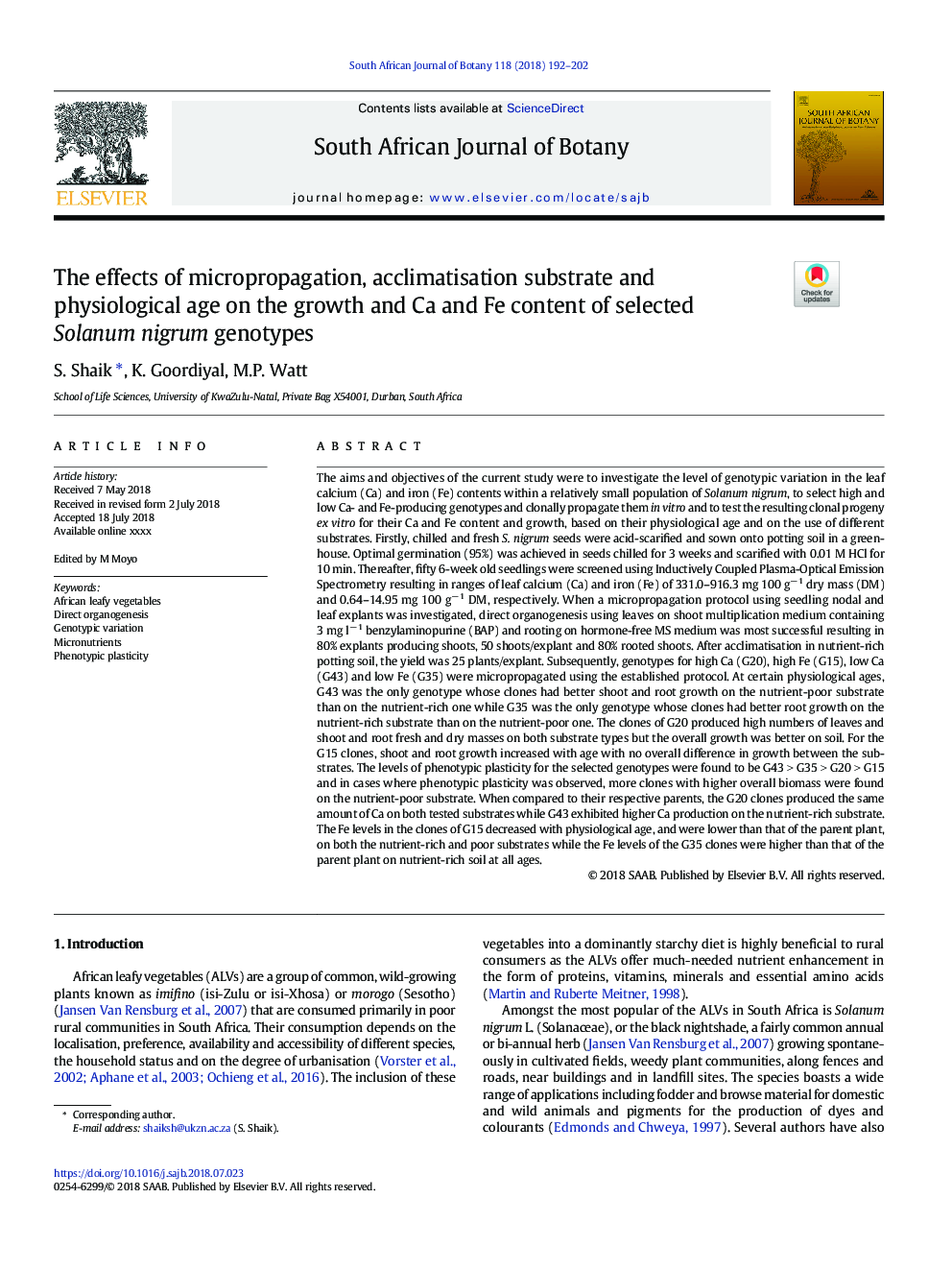| Article ID | Journal | Published Year | Pages | File Type |
|---|---|---|---|---|
| 8882226 | South African Journal of Botany | 2018 | 11 Pages |
Abstract
The aims and objectives of the current study were to investigate the level of genotypic variation in the leaf calcium (Ca) and iron (Fe) contents within a relatively small population of Solanum nigrum, to select high and low Ca- and Fe-producing genotypes and clonally propagate them in vitro and to test the resulting clonal progeny ex vitro for their Ca and Fe content and growth, based on their physiological age and on the use of different substrates. Firstly, chilled and fresh S. nigrum seeds were acid-scarified and sown onto potting soil in a greenhouse. Optimal germination (95%) was achieved in seeds chilled for 3â¯weeks and scarified with 0.01â¯M HCl for 10â¯min. Thereafter, fifty 6-week old seedlings were screened using Inductively Coupled Plasma-Optical Emission Spectrometry resulting in ranges of leaf calcium (Ca) and iron (Fe) of 331.0-916.3â¯mg 100â¯gâ 1 dry mass (DM) and 0.64-14.95â¯mg 100â¯gâ 1 DM, respectively. When a micropropagation protocol using seedling nodal and leaf explants was investigated, direct organogenesis using leaves on shoot multiplication medium containing 3â¯mgâ¯lâ 1 benzylaminopurine (BAP) and rooting on hormone-free MS medium was most successful resulting in 80% explants producing shoots, 50 shoots/explant and 80% rooted shoots. After acclimatisation in nutrient-rich potting soil, the yield was 25 plants/explant. Subsequently, genotypes for high Ca (G20), high Fe (G15), low Ca (G43) and low Fe (G35) were micropropagated using the established protocol. At certain physiological ages, G43 was the only genotype whose clones had better shoot and root growth on the nutrient-poor substrate than on the nutrient-rich one while G35 was the only genotype whose clones had better root growth on the nutrient-rich substrate than on the nutrient-poor one. The clones of G20 produced high numbers of leaves and shoot and root fresh and dry masses on both substrate types but the overall growth was better on soil. For the G15 clones, shoot and root growth increased with age with no overall difference in growth between the substrates. The levels of phenotypic plasticity for the selected genotypes were found to be G43â¯>â¯G35â¯>â¯G20â¯>â¯G15 and in cases where phenotypic plasticity was observed, more clones with higher overall biomass were found on the nutrient-poor substrate. When compared to their respective parents, the G20 clones produced the same amount of Ca on both tested substrates while G43 exhibited higher Ca production on the nutrient-rich substrate. The Fe levels in the clones of G15 decreased with physiological age, and were lower than that of the parent plant, on both the nutrient-rich and poor substrates while the Fe levels of the G35 clones were higher than that of the parent plant on nutrient-rich soil at all ages.
Keywords
Related Topics
Life Sciences
Agricultural and Biological Sciences
Agronomy and Crop Science
Authors
S. Shaik, K. Goordiyal, M.P. Watt,
